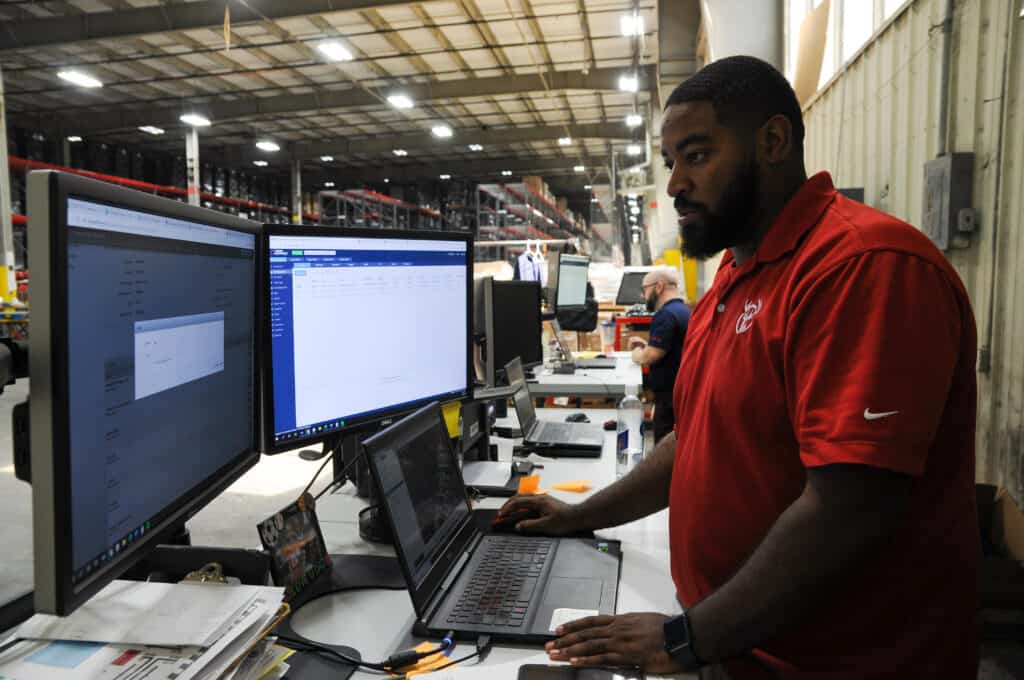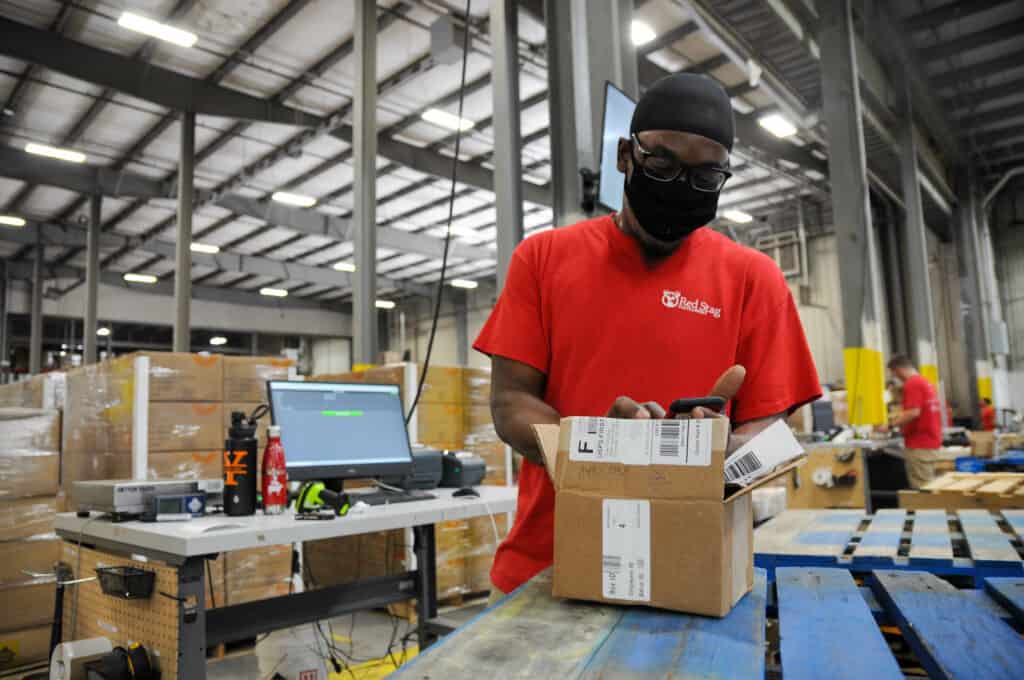Your end-to-end eCommerce process includes all the steps from when your customer places an order until that order is delivered. Looking for efficiencies can improve customer experience, reduce eCommerce fulfillment costs, and increase profit margins. Streamlining end-to-end eCommerce processes can include in-house changes and outsourcing to leverage process expertise.
This piece outlines 10 ways to restructure and simplify your process flow to support your business growth.

Getting started: Plotting your end-to-end eCommerce process flow
The first step to rationalizing your end-to-end process is to plot the steps in your current flow and the tools you use.
Start with checkout, looking at the checkout process, payment methods, and retargeting software for abandoned shopping carts. The checkout process should flow seamlessly through your eCommerce platform or ERP to order outsource your fulfillment to a warehouse or 3PL.
In the fulfillment warehouse, eCommerce processes include inventory management, pick list methods, shipping, and returns.
For each step, outline the software that powers it or the partner that provides the service. Now you’re ready to slim down and modernize your eCommerce process flow.
10 tips for streamlining your end-to-end eCommerce process
Improving your process flow is an ongoing project. Plan to regularly reevaluate your end-to-end eCommerce process to ensure that your software is up-to-date and that order processing flows smoothly. Here are 10 tips to get you started.
Ensure that the checkout on your eCommerce website is UX-friendly

User experience at checkout is critical. Enlist software and automation to do more so customers can make purchases with as few clicks as possible.
Here are some items to include in your regular checkout checkup:
- How easy is it to navigate to and from your shopping cart?
- Have you given customers options to make the process easier? That can include social sign-in, autofill of address information for returning customers, and guest checkout options.
- Do the buttons to proceed to the next step at checkout stand out visually? And, if a field is missing, make sure it’s clear to the customer what information they need to add. Also, include a back button so they can edit, but only offer navigation within the checkout process flow.
- Do you offer the payment options that your customers want and expect? Payment options are particularly critical if you sell internationally, and preferred payment modes change over time. Keep your checkout updated with the latest options for each region you ship to.
- Is your purchase confirmation clear? It should set up expectations for the next steps, such as shipping times and notifications. Follow up with an email or SMS confirmation with the order number and a customer service contact.
Consolidate your ERP suite to remove as many middle layers as possible

An ERP such as NetSuite or CommerceHub adds power to your eCommerce operations by funneling the many pieces of software you need to run your eCommerce store through a single platform.
An annual eCommerce software audit can uncover areas of duplication so you can eliminate apps whose functions are included in your ERP suite. It can also show you where you can add automation or utilize additional features in your eCommerce platform.
A well-organized eCommerce software suite where all the elements talk to each other and communicate with your 3PL is the lynchpin of a successful online enterprise.
Use automation to supercharge your capacity

Don’t skimp on automation tools to improve your end-to-end eCommerce process flow. For example, suppose you have a choice of using middleware or building an API to connect your platform to your 3PL provider. Middleware is an out-of-the-box solution with little or no upfront costs. But an API gives you a custom connection with the flexibility to automate processes and speed data flow, so, in the long run, it’s a better investment.
Inventory management automation is essential. Use your inventory management software to set reorder levels, create purchase orders, and provide reporting.
Leverage data and analytics as the foundation for better business decisions

Automation tools allow you to improve your eCommerce process flow using data and analytics rather than hunches and instincts. You don’t have to be a data scientist; many eCommerce platforms have built-in analytics. Set up a dashboard to view performance in real time and create monthly or quarterly reports to track progress on your supply chain KPIs.
Once again, inventory planning is a critical area where analytics can help you run your business more effectively. Use data on sales velocity, supply chain costs, inventory levels, and returns to determine which SKUs are most profitable. That data can guide your marketing and product development efforts toward popular products that will help expand your market share.
Outsource critical functions to improve focus on your core eCommerce business

Automation is one crucial form of outsourcing within an end-to-end solution. Using 3PL services is another.
You wouldn’t hire drivers to deliver your products (unless you’re a local florist — or Amazon) because it’s not cost-effective to provide such a widely distributed service rather than outsource it. Fulfillment is essentially the same. When you outsource your fulfillment, you bring an expert logistics department into your company without hiring a single employee. Plus, you get flexible warehouse space and optimal national fulfillment locations without the fixed overhead of owning a warehouse.
Adding superior third-party logistics to your eCommerce process flow improves customer experience because their orders are quick and correct. The fulfillment company manages the processes for inventory handling, storage, and pick and pack fulfillment, so you don’t have to. Professional fulfillment can reduce inventory shrinkage, increase order processing speed, and lead to fewer returns.
In addition, you can benefit from economies of scale at your 3PL. For instance, Red Stag Fulfillment is a high-volume shipper, so we can negotiate favorable shipping rates and dimensional weight factors, which lets us offer discounted shipping rates to our clients. And our professional warehouse staff will apply lessons learned from working with hundreds of clients to suggest ways to streamline your eCommerce process flow.
Connect your eCommerce site and platforms to your 3PL

Optimizing the tech that connects your ERP, website, or sales channels to your 3PL will boost your end-to-end eCommerce processes. A robust connection can give you real-time inventory data, allow you to track customer orders inside the warehouse and beyond, and add orders to the fulfillment queue instantly.
The best time to create a robust IT connection with your 3PL is during onboarding. But it’s a best practice to reassess your plugin, middleware, or API bridge periodically to ensure that you have the full functionality you need to move at the speed of modern eCommerce.
Build in flexibility without adding complexity

The key to eCommerce process optimization is adding choice without creating complexity. Outsourcing can give you flexibility without adding middle layers to your stack.
One example is the variable storage space you can access by working with a fulfillment center. Another is flexible carrier selection. When you aren’t locked into a contract with a single delivery service, you can use flexible carrier selection to pick the best shipping company for each package. That flexibility allows you to cut shipping costs and delivery times, benefiting your customers and business.
Plot your reverse logistics flow

Returns will probably never be a profit center, but streamlining your reverse logistics can help you reduce the costs.
No one likes returns, but ignoring the problem only makes it worse. It’s crucial to create a plan with your fulfillment warehouse for how you will handle returns. Will some items get returned to stock? Do you want to automatically divert returns to a different eCommerce flow by reselling them or using them to stock a vertical of discounted products? Creating a defined process will reduce costs even if your returns must be thrown away.
While you can’t eliminate returns, professional fulfillment is the best way to reduce the volume of returned orders. Getting the correct SKU, color, and quantity the first time eliminates the need to exchange or supplement incorrect orders. And proper packaging can prevent damage during shipping, reducing another reason that goods often get sent back.
Know where to cut corners and where to devote extra time in your end-to-end eCommerce process

You can take many steps to streamline eCommerce fulfillment and eliminate waste from your eCommerce process flow. But there are also areas where saving a little can cost you a lot.
For example, a 3PL with a high error rate or shrinkage allowance may cost less in fulfillment fees. But errors can destroy consumer confidence, increase your cost of goods sold, and slow or stop your business growth.
Another example is packaging. A heavier box costs more than thinner cardboard, but sturdier packaging can be the difference between an order arriving intact or cracked if you sell heavy or high-value products.
On the other hand, clever packaging can allow you to fit a product into a smaller box. At times, gaining even a fraction of an inch can make the difference between actual and dimensional weight in your billable weight, saving you hefty dimensional shipping surcharges.
Ask your 3PL for insights on the best places to save in your order processing flow and where spending a little extra might benefit you a lot.
Strive for constant improvement
Sweating the small stuff is integral to our culture at Red Stag Fulfillment. That’s because our 3PL was conceived by eCommerce entrepreneurs who know that continuous improvement is essential to thriving in online retail.
Constant improvement in your end-to-end process flow requires maintenance, review, and revision. ECommerce is constantly changing, so the end-to-end solutions you use to power your enterprise must change too.

How Red Stag Fulfillment helps eCommerce businesses streamline eCommerce process flow
Looking for ways to streamline and optimize eCommerce fulfillment processes is built into the DNA of Red Stag Fulfillment. We constantly improve our processes and work with our clients to find ways to enhance their logistics.
We know our business grows when yours does, and we love working with growing eCommerce businesses. Let’s find out how we can help you expand your online enterprise.

More about eCommerce process flow:





